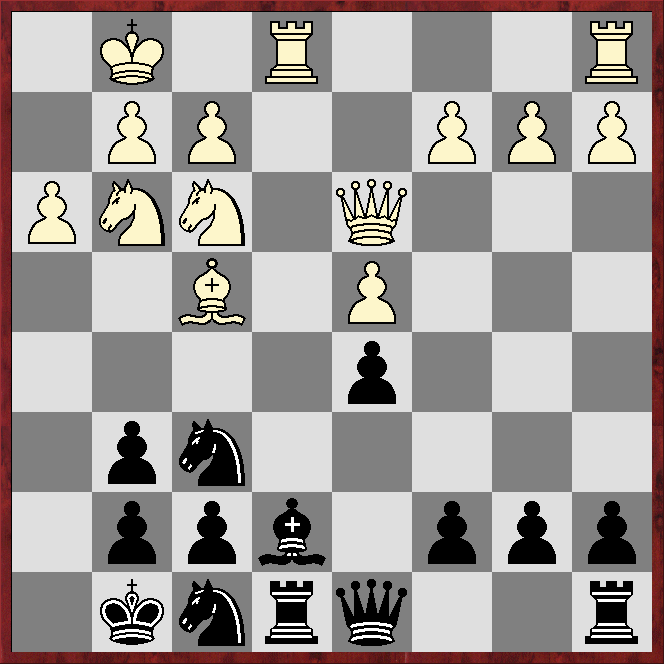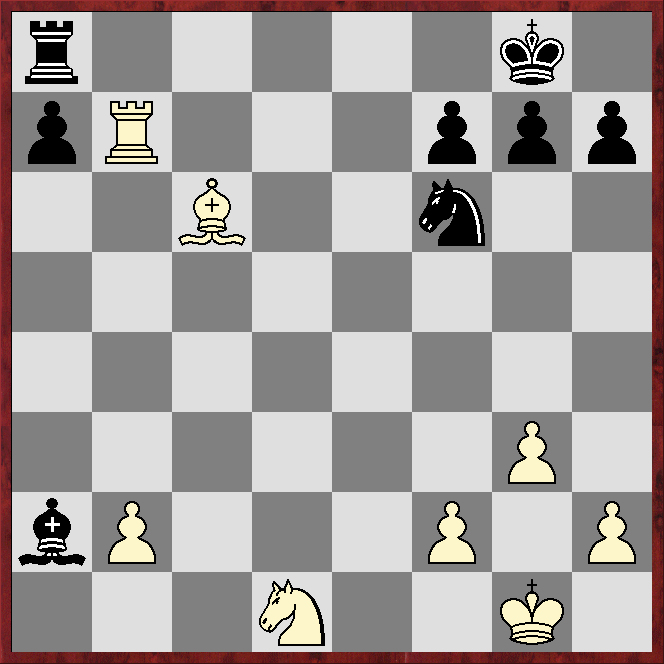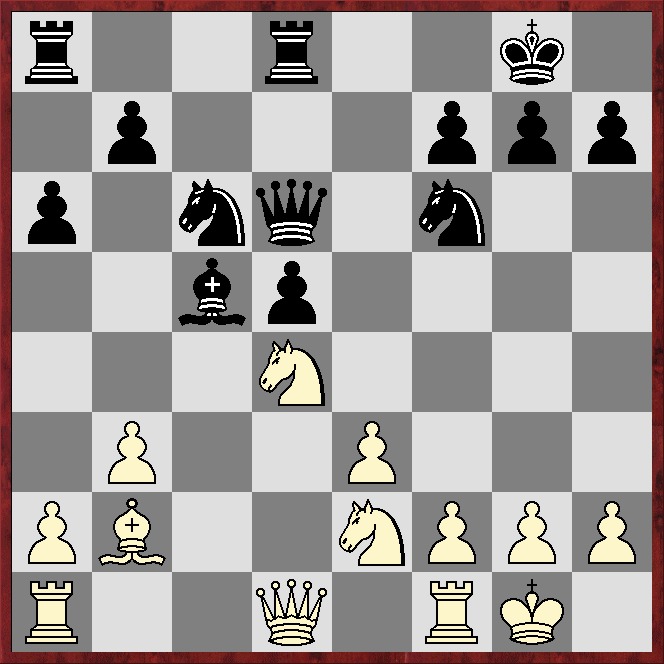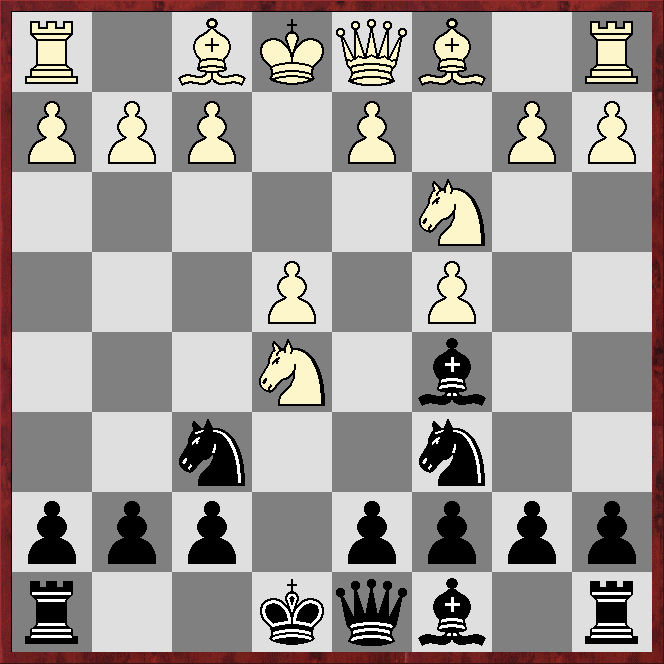WHEN going through a book of games listed by opening it is natural to expect the first entry in the King's Gambit section to be special.
Here is the first King's Gambit in 500 Master Games of Chess by Savielly Tartakower and Julius du Mont.
Notes in italics are algebraicised from the book.
Lionel Kieseritzky - Ignazio Calvi
Match (Paris) 1842*
1.e4 e5 2.f4 exf4 3.Nf3 g5
The 'classical defence'.
4.h4
The most energetic reply.
4...g4 5.Ne5
Known as the 'Kieseritzky Gambit', this 'gambetto grande' was already well known in the 16th century.
It is easily the most popular continuation in ChessBase's 2024 Mega database.
5...h5!?
An ancient idea which scorns the consolidation of the inner lines, which is obtained chiefly by developing the pieces 5...Bg7 or 5....Nc6 or 5...Nf6 or 5....d5, followed by ...Nf6.
Stockfish16.1 and Dragon1 strongly dislike the text, preferring 5...Nf6, 5...d6 or 5...Qe7!?
6.Bc4 Rh7!?
A painstaking rook!
7.d4 d6 8.Nd3
 |
| How should Black proceed? |
*****
*****
*****
*****
*****
8...f3!
The engines agree this is best. The point is a developing move, eg 8...Be7, allows White to develop smoothly with 9.Bxf4. This was illustrated in Harry Pillsbury - A Lissek, Vienna Blindfold Simul 1902, which continued 9...Bxh4+ 10.g3 Bg5 11.Nc3 Nc6 12.Bxg5!? Qxg5 13.Nf4 Nf6 14.Nd5?! Nxd5 15.Nxd5 f5?! 16.Qd3 with a position that remained sharp (1-0, 56 moves).
9.gxf3 c6?!
The engines reckon this is too slow, preferring 9...Nc6 or 9...Be7.
10.Nf4
Preventing both 10...d5 and 10...Be6.
10...Ne7?!
Less cumbersome would be 10...Nf6. The queen's knight could later on be developed via d7 to b6, and the king's bishop could find employment by ...Bh6 and eventually ...Bxf4.
11.Nc3 Nd7 12.Kf2?!
The engines are strongly against committing the king like this.
12...Rh8?!
Or first 12...Bg7 13.Qd3, and now only 13...Rh8 in view of the threat 14.e5.
The engines want to start opening lines to the white king with 12...gxf3, eg 13.Qxf3 Qb6 with ...Ne5 on the horizon.
13.Qd3 Bg7 14.Bd2 Kf8?!
The king relinquishes the critical e file, but remains in the danger zone.
Both Kieseritzky and Calvi are playing imaginatively, but dubiously, with their kings. The engines suggest 14...b5 or 14...Qb6.
15.Rae1 Qb6 16.Be3 Qc7?!
16...Qxb2 would be too risky.
Grabbing the b pawn is well-met by 17.Bb3 or 17.fxg4, according to the engines, but they reckon much better than the text is 16...gxf3.
17.Be6
A pretty episode.
Winning, according to the engines, is 17.Bxf7!? Kxf7 18.Qc4+, and even stronger, they reckon, is first 17.fxg4!?
17...b5
Hoping that the moment is favourable for a counteraction on the queenside.
18.b4?!
The engines reckon this throws away White's advantage, preferring 18.fxg4.
18...Nb6 19.Bb3 a5 20.a3 a4 21.Ba2 Bb7?
Rather than hope for things to happen in the distant future, he should have played 21...Bd7.
More to the point, according to the engines, is 21...d5 or 21...gxf3.
22.e5?!
Piercing the front.
The engines much prefer 22.fxg4 or 22.Nce2.
 |
| What should Black play? |
*****
*****
*****
*****
*****
22...d5?!
He tries to keep the lines closed, for if eg 22...dxe5 23.dxe5 Bxe5 (or 23...Rd8 [then] 24.Bd4 etc) 24.Bd4 Bxd4+ 25.Qxd4 Rh7 26.Qf6 and wins.
The engines disagree with much of this analysis, eg they reckon 25...Rh6 is at least equal for Black. However they give 24.Bc5! as winning for White, the main threat being 25.Qf5. Therefore they reckon best is 23...Rd8, meeting 24.Bd4 with 24...Nd7, claiming at least a slight edge for Black.
23.e6
Energetic play.
The engines again much prefer fxg4 or Nce2.
23...Bc8 24.Bc1 Qd6 25.exf7 Kxf7?
A decisive mistake, allowing the hostile knight to get powerfully into play. Better would be the intermediary measure 25...Bf5, although Black's position would still be uneasy after 26.Qd2 Kxf7 27.Nce2 etc.
The engines agree the text is a mistake, but want to meet 25...Bf5 with 26.Ne4!? as they reckon 26.Qd2 gxf3 is good for Black. After 26.Ne4!? dxe4 (26...Qd7 may be better) 27.fxe4 Black should probably return the piece with 27...Ng6!?, as saving the bishop with, for example, 27...Bc8 can be met by the calm 28.c3!? with what the engines reckon is more than enough compensation for a knight.
26.Ne4 Qc7?!
Both 26...Qd7 and 26...Qd8 seem less worse.
27.Ng5+ Kg8 28.Rxe7?!
A sacrifice which has the double task of eliminating a defending piece and of speeding up the concentration of his own forces.
The engines reckon this lets Black back into the game, whereas 28.Ng6 seems overwhelming.
28...Qxe7 29.Re1 Qf6!?
He tries in vain to establish some counterscheme.
 |
| The engines like the text, giving White at best a slight edge |
*****
*****
*****
*****
*****
30.Re8+ Bf8 31.Ng6 Bf5?
Completely equal, according to the engines, is 31...Bd7, eg 32.Rxa8 Nxa8 33.Nxh8 Bf5 and 34...Kxh8.
32.Qxf5!
Winning a piece.
32...Qxf5 33.Ne7+ Kg7 34.Nxf5+ Kf6 35.Re6+!? Kxf5 36.Bb1 1-0
White mates in two.
The game well-illustrates how difficult it is to analyse a sharp game reasonably accurately without an engine.
*It is listed in the book simply as "Paris, 1847," but was the first game of their match played in the French capital five years earlier.





















































